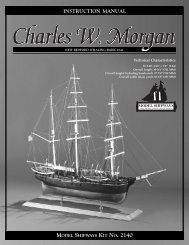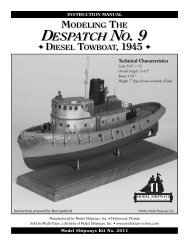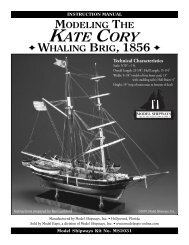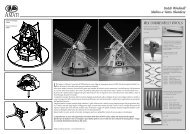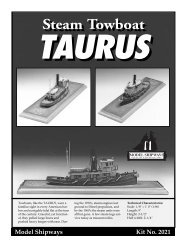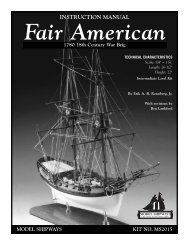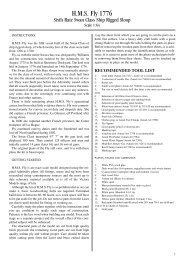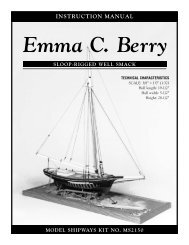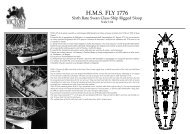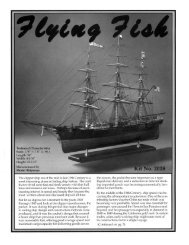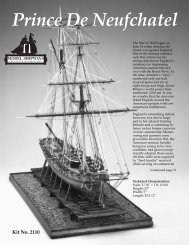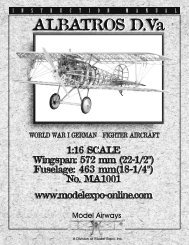download benjamin latham instruction manual
download benjamin latham instruction manual
download benjamin latham instruction manual
Create successful ePaper yourself
Turn your PDF publications into a flip-book with our unique Google optimized e-Paper software.
8. Installing Horn Timber Cheeks<br />
From just forward of the hull/sternpost intersection to the<br />
transom, fit a 1/8”-square piece between each bulkhead on<br />
both sides. These “cheek” pieces are located slightly more than<br />
1/16” up from the bottom of the center keel. This area of the<br />
center keel represents a horn timber on a real ship. The cheeks<br />
are for attaching the hull planks at the horn timber. On a real<br />
ship they are bolted to the horn timber (see figure 12).<br />
Notice in the sketch that the bottom of the horn timber from<br />
the sternpost aft is not completely flat, but is a shallow vee<br />
shape. After the planking is installed, this vee can be sanded<br />
in, or you can cut it before planking.<br />
FIG. 11 – Installing the Transom<br />
Transom<br />
Make template for<br />
correct transom angle<br />
Bulkhead “N”<br />
9. Installing the Planksheer<br />
A large ship, such as a clipper, has a separate planksheer, waterway,<br />
and nibbing strake for deck planking. On the fishing<br />
schooner, one piece serves all three functions. The outboard<br />
edge of the planksheer is flush with the outside hull planking,<br />
and the top of the plank is flush with the deck planking. Nibs<br />
are cut into the inboard edge for the deck planks.<br />
On the larger real vessel, the planksheer (or planksheer-waterway<br />
in this case), would be a solid piece with holes cut out for<br />
the bulwark stanchions. With holes cut, the planksheer then<br />
would be slipped over the stanchions. For the model, each<br />
planksheer-waterway section is made up of two pieces. A<br />
laser-cut piece has slots for the stanchions on the outer edge at<br />
each bulkhead. After this piece is installed, a 1/16”-square<br />
strip will be added to the outboard edge to complete the model<br />
planksheer.<br />
FIG. 12 – Installing Horn Timber Cheeks<br />
Center keel<br />
Glue<br />
Temporary batten<br />
on each side<br />
Bulkhead “N”<br />
Bulkhead<br />
“M”<br />
At this time, there are no nibs cut into the inboard edge of the<br />
planksheer. Cut the nibs during the deck planking process in<br />
order to avoid errors.<br />
It may be necessary to file the planksheer slots so they fit snugly<br />
around the stanchions. Also, the aft end of the quarter deck<br />
planksheer is longer than required. Cut the end to fit against<br />
the transom. The forward end of the quarter deck planksheer<br />
should be flush with the front edge of Bulkhead “G.” The fore<br />
deck planksheer should butt against the Bulkhead.<br />
Glue the planksheer pieces in place. The upper outboard edge<br />
of the planksheer pieces should be flush with the outside of<br />
each bulkhead. When in place, add a 1/16”-square basswood<br />
strip on the outside edge (see figure 13). After the hull planking<br />
is completed, the outer edge of the planksheer can be sanded<br />
flush with the hull planks.<br />
10. Installing the Hawse Timbers<br />
The hawse timbers can be a single 1/8”-thick piece at the forward<br />
end as shown on the plans (also look ahead to figure 22a).<br />
Glue the timbers to the top of the planksheer. You can cut the<br />
hawse pipe before you install the timbers if desired. Make sure<br />
you leave space for the bowsprit to pass through at the bow.<br />
Most of the basic framing is now completed and you should be<br />
ready to start planking. Take a moment to look over what you<br />
have done so far. Recheck the fairness of the hull. Making corrections<br />
now will allow the planking process to go smoothly.<br />
Hull<br />
plank<br />
Shallow vee cut<br />
on center keel<br />
FIG. 13 – Installing the Planksheer<br />
Laser cut<br />
planksheer<br />
BEFORE PLANKING<br />
1/8” square<br />
horn timber cheek<br />
Flush here<br />
1/16” square strip<br />
glued to edge<br />
Sand flush with<br />
hull planks<br />
AFTER PLANKING<br />
13



